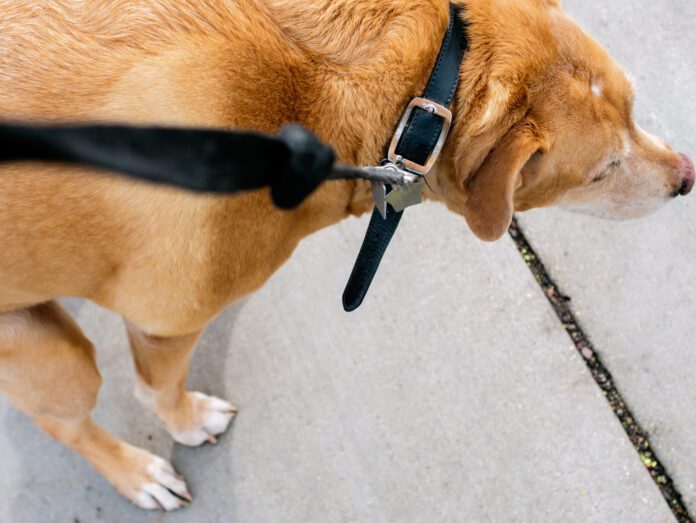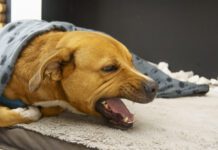For both dogs and humans, fiber provides bulk to the diet, aids bowel regularity, and promotes the growth of beneficial bacteria in the gut. So, not surprisingly, the first signs that your dog may need more fiber in his diet are often chronic diarrhea or constipation. Always add all types of fiber gradually. Overfeeding fiber can cause diarrhea, constipation, and give your dog an upset stomach.
Foods That Add Fiber to Your Dog’s Diet
Pumpkin is perhaps the most widely recommended natural source of fiber for dogs. Canned pure pumpkin (not spiced/sweetened pumpkin pie filling) and dehydrated pumpkin powder can be used to alleviate both constipation and diarrhea due to its soluble fiber content and gentle impact on the stomach. A starting place for adding canned pumpkin to your dog’s diet is a half to a full teaspoon for a small dog (20 lbs and under), a tablespoon for a medium dog (between 21 and 35 lbs), and 2 tablespoons for a large dog over 35 lbs.
Sweet potatoes are an excellent source of fiber and provide beneficial vitamins and antioxidants. As with pumpkin, consider starting with a half to a full teaspoon for a small dog (20 lbs and under), a tablespoon for a medium dog (between 21 and 35 lbs), and 2 tablespoons for a large dog over 35 lbs.
Green beans, carrots, apples, and leafy greens like spinach or kale are rich in fiber and safe in moderation, such as for treats. Green beans and carrots are favorites for many dogs.
Cooked brown rice and whole oats (plain, no additives cooked oatmeal) can both contribute fiber while also providing energy in the form of complex carbohydrates. Brown rice can be fed at a ¼ cup to a 1 cup depending upon your dog’s size. For cooked oatmeal, start with about a spoonful of cooked oatmeal at a time. You can work up to about 6 ounces of oatmeal a day per 25 pounds of the dog’s bodyweight.
What Dietary Fiber Does for Your Dog
Dogs cannot digest dietary fiber. Nevertheless, when fed at the proper quantity as a good dietary source of fiber or a fiber supplement, this indigestible material can have a positive impact on your dog’s microbiome, gut health, and stool quality. Dietary fiber can help dogs with loose stools or diarrhea and add bulk to the diet of a dog who needs to lose weight.
Fiber also provides benefits that selectively favor the growth and/or activity of the gut’s native beneficial bacteria species, which in turn:
- Produce short chain fatty acids, which
- Help maintain intestinal electrolyte and fluid balance
- Inhibit the growth of pathogenic microbes
- Provide an energy source for intestinal cell function and replication
There are two types of dietary fiber, fermentable fiber (also known as soluble fiber) and nonfermentable fiber (also known as insoluble fiber).
Fermentable Fiber
Fermentable fiber cannot be broken down by the dog and passes through the small intestine largely unchanged by digestion. When fermentable fiber reaches the large intestine, the bacteria that reside therein chemically breaks it down and uses it as a food source. These bacteria produce short chain fatty acids, which are the preferred form of energy for our pet’s colon cells. These short chain fatty acids are absorbed by the intestines and help to promote a healthy gut by providing an energy source for cellular function and replication.
Short chain fatty acids also help to prevent diarrhea in dogs by maintaining intestinal electrolyte and fluid balance, enhancing the absorption of sodium, promoting the growth of beneficial intestinal microflora, and inhibiting the growth of pathogenic microbes. Dogs who consume diets containing fermentable fiber have increased colon weights and increased intestinal surface area compared to dogs fed diets containing nonfermentable fiber. The result? Dogs fed a diet containing fermentable fibers have greater potential for water absorption than those not fed fermentable fibers.
The major sources of fermentable fiber used in commercial canine diets include cereal grains, legumes, and other plant ingredients such as beet pulp and rice bran. These soluble fibers also have the capacity for binding to water, which can increase the viscosity of the intestinal contents, slowing gastric emptying. This is especially helpful for dogs suffering from loose stools or diarrhea, as these soluble fibers in the diet can help bind the excess water present in the intestines.
Some fermentable fibers also act as prebiotics, which are food ingredients that provide benefits by selectively favoring the growth and/or activity of the native beneficial bacteria species (such as Bifidobacterium and lactobacilli) that reside within the colon of the host animal. Prebiotics impact the gut microbiome by acting as a food source for these beneficial bacterial colonies within the dog’s intestinal tract.1
Providing prebiotic fiber in conjunction with probiotics (beneficial bacterial species fed to the dog in the form of dietary supplements) helps to ensure that the beneficial bacteria you are supplementing your pet with have everything they need to thrive. Inulin is commonly used as a prebiotic fiber supplement in diets and is typically sourced from chicory root. Other varieties of prebiotics can be found naturally in ingredients such as fruits, vegetables, grains, psyllium, and sugar beet root.1,2
While fermentable fiber is an important factor for the maintenance of gut health in your dog, the amount and type of fermentable fiber should be considered, as large amounts have the potential to cause digestive upset. One of the byproducts of bacterial fermentation is gas, meaning that too much highly fermentable fiber can be the cause of flatulence and stomach discomfort. Because of this, moderately fermentable fibers, such as beet pulp or rice bran, are preferrable to highly fermentable fibers like pectin and guar gum. Other fibers, such as cellulose, locust bean gum, and xanthium gum, have very low fermentability and are less likely to cause excess gas production but are also less effective for the production of short chain fatty acids.
Nonfermentable or Insoluble Fiber
Nonfermentable carbohydrates, or insoluble fiber, are comprised of the non-digestible components of plants (such as cellulose) that are not easily fermented by intestinal microbiota. This type of fiber is also termed bulk fiber, as it helps with stool bulking when added to the diet. This type of fiber is especially useful when considering foods for dogs who are overweight or who gain weight easily, as insoluble fiber provides bulk to the diet without adding calories. Insoluble fiber also helps to normalize intestinal transit rate and can help bind water and toxins in the intestinal tract.
Sources of insoluble fiber include beet pulp, fruit and vegetable pomaces, bran, and cellulose.
Slowly Introduce High-Fiber Foods to Your Dog
Gradually introduce high-fiber foods or supplements, as a sudden increase in fiber can lead to bloating, gas, constipation, or diarrhea as your dog’s system adjusts. Transitioning slowly over the course of a week or 10 days allows the gut microbiome to adapt and reduces the risk of discomfort. Adequate water intake is also essential when increasing dietary fiber, as fiber absorbs water and can lead to constipation if a dog is not well-hydrated.
Incorporating fiber into your dog’s diet can offer a range of health benefits, from improved digestion to better weight management. As with any dietary change, it is important to consult with your veterinarian to determine the right amount and type of fiber to suit your individual dog’s needs.
References:
- Nutrient requirements of dogs and cats. (2018). The National Academies Press.
- Case, L. P., Daristotle, L., Hayek, M. G., & Raasch, M. F. (2011).Canine and Feline Nutrition: A resource for companion animal professionals. Mosby.







My dog loves to eat the sweet spring grass. Lately I have noticed both of them craving greens. They pulled out my green bean plants from the garden, ate the beans and then started eating the leaves.
Is there something in their diet that is lacking or do they just like a little “salad” in their diet?
I’ve been giving them a few cucumber peels and they love those too.
Does adding fiber help with anal glands? Will it loosen the thick expulsed material and lessen impaction?